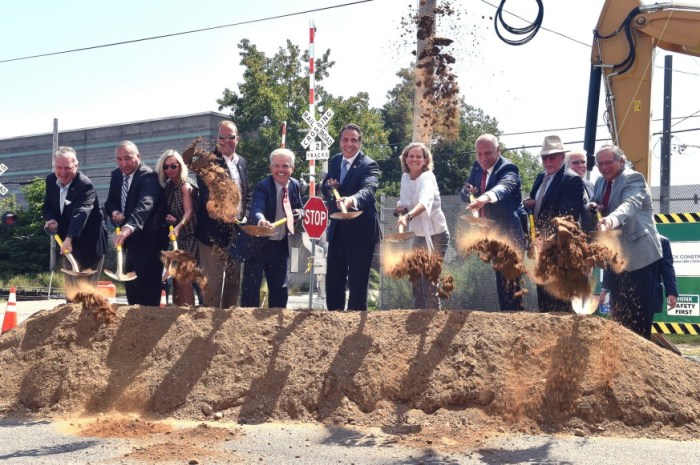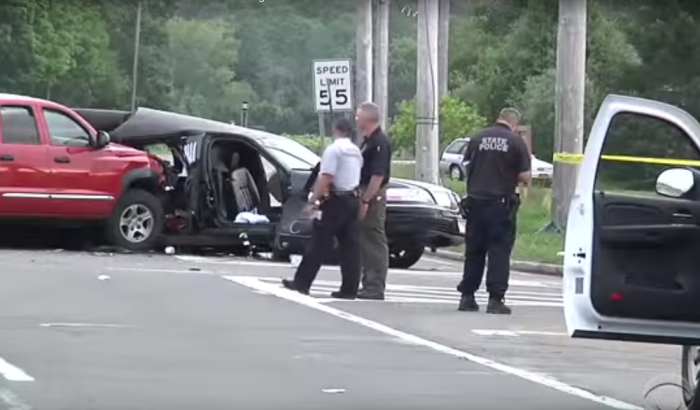Investigators are attempting to determine what caused a Long Island Rail Road train packed with more than 400 commuters to crash through a support block as it entered Atlantic Terminal in Brooklyn Wednesday morning, leaving more than 100 of passengers injured. None of the injuries was considered serious.
The front two cars of the commuter train partially derailed after ramming a bumping block at the end of Track 6 in the terminal.
An investigator with the National Transportation Safety Board said Wedensday night that 104 people sustained minor injuries in the 8:20 a.m. crash. The crash disrupted the commute for thousands of people. Aaron Neufeld, 26, said he was in the train’s second car when the crash occurred. “The speed wasn’t that out of the norm,” he told reporters. People were standing in the vestibule ready to disembark.” On impact, “people were thrown to the ground and bags went flying,” he told reporters. Shattered glass, bloody faces, and people crying surrounded him within minutes.
Gov. Andrew Cuomo and MTA chairman Tom Predendergast said during a news conference that the train engineer and conductor were being questioned, and the cause of the crash was under investigation.
The most serious injury was a possible broken leg that a female passenger sustained, Cuomo said.
The train began its route in Far Rockaway, Queens.
Some of the injured were treated at area hospitals, but many of the passengers walked away or were treated at the scene, so it was difficult to know precisely how many people were hurt, officials said. Most of the passengers who were injured were standing as the train was pulling into the station. “There was a sudden stop. They weren’t ready,” Cuomo said.
103 injuries reported at scene of Atlantic Terminal LIRR train derailment, all non-life-threatening pic.twitter.com/t5p78cAFlU
— FDNY (@FDNY) January 4, 2017
76 non life-threatening injuries reported at scene of LIRR train derailment, Atlantic Terminal Brooklyn pic.twitter.com/rFcimgfK2C
— FDNY (@FDNY) January 4, 2017
The governor said the train was traveling at a “fairly low rate of speed.”
Police closed roads in the vicinity of the terminal on Atlantic and Flatbush avenues as the investigation continued and emergency crews treated injured passengers. The Federal Railroad Administration said on Twitter that its investigators were dispatched to the scene. Officials expected that evening rush-hour commuters would not be affected, and trains would be running on schedule.
#NOW: #ESU & @FDNY #EMS treating injured commuters @ the @LIRR Train Derailment @ F’bush Avenue Terminal @NYPD78Pct. Multiple minor injuries pic.twitter.com/mWPJMsQ7pM
— NYPD Special Ops (@NYPDSpecialops) January 4, 2017
The trains automatic brakes are not activated at low speeds,Prendergastsaid, when trains generally enter a station between 10 and 15 mph. The train “is supposed to stop short of the bumping block,” he said. He added that cameras on the trains are being installed throughout the system, but are not yet operational.
Cuomo called the accident was far less serious than the Sept. 29 incident involving a New Jersey Transit train that crashed into the Hoboken station, killing one woman and injuring more than 100 other people. That train did not stop as it went into the station, going over bumping posts and hitting the wall of the terminal. “Hoboken was much worse,” said the governor. “I was in Hoboken.” He said that train was approaching the station much faster than the one this morning. “This is minor compared to Hoboken.” Alexi Friedman and Amanda Mikelberg contributed to this report.























